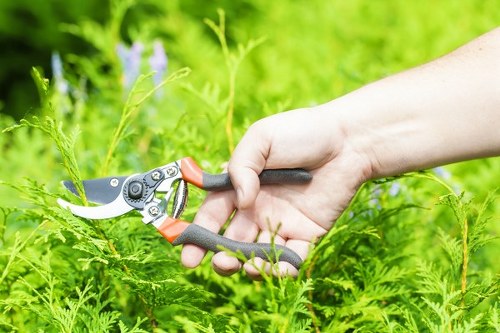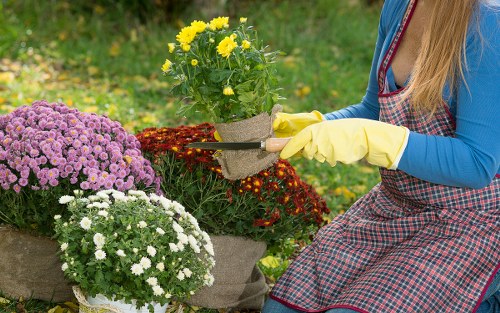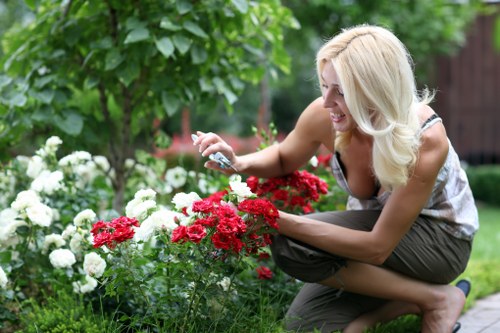Landscaping Woodlands

Landscaping woodlands is a rewarding endeavor that combines the beauty of nature with the art of design. Creating a well-planned woodland landscape not only enhances the aesthetic appeal of your property but also promotes biodiversity and sustainability. Whether you’re looking to transform a small backyard or a sprawling forested area, understanding the principles of woodland landscaping is essential.
One of the primary benefits of landscaping woodlands is the creation of a serene and natural environment. Thoughtfully designed woodlands can serve as a peaceful retreat, offering a place to relax and connect with nature. Additionally, properly landscaped woodlands contribute to the overall health of the ecosystem by providing habitat for various wildlife species.
In this guide, we will explore the key aspects of landscaping woodlands, including planning, plant selection, sustainable practices, and maintenance tips. By following these guidelines, you can create a beautiful and functional woodland landscape that stands the test of time.

Benefits of Landscaping in Woodlands
Landscaping woodlands offers numerous advantages that go beyond mere aesthetics. Here are some of the key benefits:
- Enhanced Biodiversity: A well-landscaped woodland supports a diverse range of plant and animal species, promoting a healthy ecosystem.
- Environmental Protection: Trees and plants help in conserving soil, reducing erosion, and improving air quality.
- Property Value: Beautifully landscaped woodlands can significantly increase the value of your property.
- Recreation and Leisure: Landscaped areas provide spaces for activities such as hiking, bird watching, and picnicking.
By focusing on these benefits, you can create a woodland landscape that is not only visually appealing but also ecologically significant.

Planning Your Woodland Landscape
Assessing Your Land
Before you begin the landscaping process, it’s crucial to assess the current state of your woodland. Consider factors such as soil quality, sunlight exposure, existing flora and fauna, and topography. Understanding these elements will help you design a landscape that is both sustainable and harmonious with the natural surroundings.
Take note of any areas that may require improvement, such as poor drainage spots or areas prone to erosion. Addressing these issues early on can prevent future problems and ensure the long-term success of your woodland landscape.
Additionally, identifying the native plants and trees in your area can provide a solid foundation for your landscaping efforts. Native species are well-adapted to the local climate and soil conditions, making them easier to maintain and more resilient against pests and diseases.

Designing with Purpose
When planning your woodland landscape, it’s important to have a clear vision of what you want to achieve. Whether your goal is to create a habitat for wildlife, establish a serene retreat, or enhance property value, having a defined purpose will guide your design decisions.
Consider incorporating elements such as walking paths, seating areas, and water features to enhance the functionality of your woodland. These features not only add interest to the landscape but also encourage interaction with nature.
Furthermore, integrating sustainable practices into your design, such as using native plants and minimizing lawn areas, can reduce maintenance efforts and promote environmental health.

Choosing the Right Plants
Native vs. Non-Native Plants
Selecting the appropriate plants is a cornerstone of successful woodland landscaping. Native plants are generally the best choice as they are adapted to the local climate, require less maintenance, and support native wildlife. Examples of native trees include oak, pine, and maple, while common native shrubs and groundcovers can range from azaleas to ferns.
Non-native plants can also be incorporated to add variety and visual interest. However, it’s important to choose non-invasive species that won’t disrupt the local ecosystem. Always research the potential impact of non-native plants before introducing them to your woodland landscape.
Additionally, consider the seasonal colors and textures that different plants offer. Combining a variety of species can ensure that your woodland remains attractive throughout the year.

Plant Selection Tips
When selecting plants for your woodland landscape, consider the following tips:
- Sunlight Requirements: Ensure that the plants you choose are suited to the light conditions of different areas within your woodland.
- Soil Preferences: Match plants to the soil types present in your landscape to promote healthy growth.
- Water Needs: Group plants with similar water requirements to optimize irrigation efforts.
- Growth Habits: Consider the mature size and spread of plants to avoid overcrowding and competition.
Proper plant selection not only enhances the beauty of your woodland but also ensures that the ecosystem remains balanced and resilient.

Sustainable Landscaping Practices
Minimizing Environmental Impact
Sustainable landscaping is essential for maintaining the health and longevity of your woodland. This involves practices that reduce environmental impact, conserve resources, and support biodiversity.
One effective strategy is to reduce the use of chemical fertilizers and pesticides. Opt for organic alternatives that are less harmful to the environment and promote natural pest control methods. Additionally, implementing composting practices can enrich the soil naturally, providing essential nutrients to your plants.
Another important aspect of sustainable landscaping is water conservation. Installing rain barrels, drip irrigation systems, and selecting drought-tolerant plants can significantly reduce water usage.

Promoting Biodiversity
Encouraging a diverse range of plant and animal species in your woodland landscape enhances ecosystem resilience. Diverse plantings provide various food sources and habitats, supporting a wide array of wildlife.
Incorporate a mix of trees, shrubs, herbaceous plants, and groundcovers to create different layers and niches within your woodland. This not only adds visual interest but also improves ecological balance.
Additionally, consider installing features like birdhouses, bat boxes, and insect hotels to attract and support different species, further enhancing biodiversity.

Maintenance Tips for Woodland Landscaping
Regular Upkeep
Maintaining a landscaped woodland requires regular upkeep to ensure that plants remain healthy and the landscape stays attractive. Regular tasks include pruning, weeding, mulching, and monitoring for pests and diseases.
Pruning helps to shape plants, remove dead or diseased branches, and promote healthy growth. Weeding prevents competition for resources and maintains the desired appearance of your woodland.
Mulching is beneficial as it helps to retain soil moisture, suppress weeds, and regulate soil temperature. Use organic mulches like wood chips or bark to enhance soil fertility over time.

Seasonal Maintenance
Different seasons require different maintenance activities to keep your woodland landscape in top condition. In spring, focus on planting new species, applying fertilizers, and preparing the soil. Summer maintenance involves watering, pest control, and managing plant growth.
Fall is an ideal time for leaf removal, pruning, and preparing plants for winter. In winter, protect sensitive plants from harsh weather conditions and plan for the upcoming growing season.
Adapting your maintenance routine to each season ensures that your woodland remains healthy and vibrant throughout the year.

Enhancing Wildlife Habitat
Creating Shelters
A key goal of woodland landscaping is to create habitats that support local wildlife. Providing shelters such as birdhouses, bat boxes, and brush piles can attract a variety of species to your woodland.
Additionally, maintaining a mix of dense vegetation and open spaces allows animals to find both cover and foraging areas. Planting native shrubs and trees provides necessary food sources and nesting materials.
Avoiding the use of pesticides and other chemicals ensures that wildlife remains safe and healthy within your landscaped area.

Water Sources
Incorporating water features like ponds, streams, or birdbaths can greatly enhance the attractiveness of your woodland landscape to wildlife. Water sources provide essential hydration for animals and serve as a focal point for your design.
When designing water features, consider the size and depth necessary to support different types of wildlife. Ensure that water is clean and free from contaminants to maintain the health of aquatic species.
Additionally, strategically placing water sources can create microhabitats, promoting greater biodiversity within your woodland.

Using Hardscaping Elements
Paths and Walkways
Incorporating hardscaping elements like paths and walkways enhances the functionality and accessibility of your woodland landscape. Well-designed paths guide visitors through the woodland, allowing them to enjoy different areas while minimizing impact on the natural environment.
Choose materials that blend with the natural surroundings, such as gravel, stone, or wood. Curved paths create a more natural feel, while straight paths can provide clear navigation routes.
Including features like benches, bridges, and signposts can further improve the user experience and add points of interest along the pathways.

Seating Areas
Designating areas for seating and relaxation within your woodland landscape encourages visitors to spend more time enjoying the natural surroundings. Benches, gazebos, or picnic tables can provide comfortable spots for rest and contemplation.
Position seating areas in scenic locations, such as near water features or viewpoints, to maximize the visual and sensory experience.
Incorporating natural materials and ergonomic designs ensures that seating elements complement the overall aesthetic of the woodland.

Incorporating Water Features
Ponds and Streams
Water features add a dynamic element to woodland landscaping, attracting wildlife and creating soothing sounds. Ponds and streams can serve as focal points, enhancing the overall ambiance of the woodland.
When designing ponds or streams, consider factors such as size, depth, and water source to ensure they meet the needs of both humans and wildlife. Incorporating native aquatic plants can improve water quality and provide habitat for aquatic organisms.
Maintain water features regularly by removing debris, controlling algae growth, and ensuring proper water flow to sustain a healthy aquatic ecosystem.

Birdbaths and Water Basins
Smaller water features like birdbaths and water basins are excellent additions to woodland landscapes. They provide essential hydration for birds and other small wildlife, especially during dry periods.
Place birdbaths in open areas where birds can easily access them and feel safe from predators. Regularly clean and refill birdbaths to maintain water quality and prevent the spread of diseases.
Enhancing water basins with features like rocks and plants can create a more natural appearance and attract a wider variety of species.

Lighting and Safety in Woodland Landscapes
Strategic Lighting
Proper lighting is essential for both safety and ambiance in woodland landscapes. Strategically placed lights illuminate paths, seating areas, and key features, enhancing visibility and security during evening hours.
Use eco-friendly lighting options such as solar-powered lamps or LED lights to minimize energy consumption and reduce environmental impact. Aim for subtle lighting that highlights the natural beauty of the woodland without causing light pollution.
Incorporating motion-sensor lights can provide additional security by deterring wildlife intruders and unwanted visitors.

Safety Measures
Ensuring safety in woodland landscapes is crucial for the well-being of visitors and the preservation of the environment. Clear pathways free of obstacles reduce the risk of trips and falls, while visible signage helps guide visitors and inform them of any potential hazards.
Regularly inspect and maintain infrastructure such as bridges, benches, and lighting fixtures to prevent accidents and ensure everything remains in good condition.
Additionally, creating buffer zones around water features and sensitive areas minimizes human disturbance and protects both visitors and wildlife.
Local Relevance: Nearby Areas to Woodlands

Understanding the local context is vital for effective woodland landscaping. Here are some of the closest areas to Woodlands that offer unique features relevant to landscaping:
- The Woodlands Park: Located just 2 miles north, this park provides ample space for community events and features diverse plant species.
- Lakeside Grove: A 3-mile eastern neighbor known for its picturesque lake and walking trails, perfect for integrating water features.
- Maple Ridge: Situated 4 miles west, Maple Ridge offers a variety of maple trees that add seasonal colors to the landscape.
- Greenfield Meadows: 5 miles south, this area is renowned for its open meadows and wildflower blooms, ideal for pollinator-friendly gardens.
- Brookside Woods: Located 6 miles northeast, Brookside Woods is a dense forest area perfect for enhancing wildlife habitats.
- Sunnyvale Orchard: 7 miles southeast, known for its fruit-bearing trees and agricultural landscape elements.
- Pine Hill: 8 miles northwest, featuring tall pine trees and rocky terrains that offer unique landscaping opportunities.
- Riverbend: Situated 9 miles southwest, this area provides a winding river that can be incorporated into water feature designs.
- Heritage Park: 10 miles east, showcasing historical landmarks and mature trees that add character to the landscape.
- Silver Creek: 11 miles north, famous for its clear creek and surrounding flora, perfect for serene woodland designs.

These nearby areas offer a variety of natural features and landscapes that can inspire and influence your woodland landscaping projects. By considering the characteristics of each area, you can create a cohesive and harmonious environment that reflects the unique beauty of Woodlands and its surroundings.
Frequently Asked Questions
1. What are the best native plants for landscaping woodlands?
Some of the best native plants for woodlands include oak, pine, maple trees, azaleas, ferns, and wildflowers like black-eyed Susans. These plants are well-adapted to the local climate and support biodiversity.
2. How can I promote wildlife in my woodland landscape?
To promote wildlife, incorporate diverse plantings, provide water sources, create shelters with birdhouses and bat boxes, and avoid using pesticides. Maintaining a mix of vegetation layers also supports various species.
3. What sustainable practices should I follow in woodland landscaping?
Sustainable practices include using native plants, conserving water with drip irrigation, minimizing chemical use, composting organic waste, and designing for biodiversity. These practices help maintain a healthy and resilient ecosystem.
4. How often should I maintain my landscaped woodland?
Regular maintenance is essential and should be performed seasonally. This includes pruning, weeding, mulching, and monitoring for pests and diseases. Adjust your maintenance routine based on the specific needs of your woodland.
5. Can I incorporate hardscaping elements without disrupting the natural feel?
Yes, by choosing natural materials like stone or wood and placing elements such as paths and seating areas thoughtfully, you can enhance functionality while maintaining the natural aesthetic of your woodland landscape.




